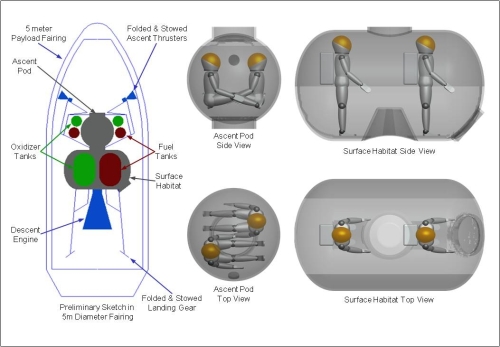Northrop Grumman Presents Lunar Lander Concept for Golden Spike
Northrop Grumman News Release
Photo Release — Northrop Grumman Completes Lunar Lander Study for Golden Spike Company
Study Identifies a New Minimalist Ascent Pod Lunar Lander Concept
REDONDO BEACH, Calif. — May 8, 2013 — Northrop Grumman Corporation (NYSE:NOC) has completed a feasibility study for a new commercial lunar lander for the Golden Spike Company (GSC). The study confirmed the viability of lander concepts for Golden Spike’s human lunar expedition architecture and conceived a novel new, low-mass ascent stage concept dubbed “Pumpkin.”
A photo accompanying this release is available at http://media.globenewswire.com/noc/mediagallery.html?pkgid=18584.
Northrop Grumman’s study for Golden Spike conducted the following tasks:
Reviewed GSC’s level one requirements and synthesized a set of study ground rules and assumptions emphasizing automated operations, simplicity and low cost.
Established propulsion requirements for lunar orbit loiter, descent to the lunar surface, ascent to low lunar orbit and rendezvous with a crew vehicle for pragmatic lunar landing sites.
Developed current and stretch factors to reflect the improvement in relevant technologies since the completion of the Apollo program.
Evaluated 180 lunar lander cases for various options and sensitivities including loiter, staging, propellants, engines, surface duration, surface cargo and technology basis.
Established a pragmatic design trade space for future more detailed analysis and development.
The study determined that for GSC’s mission architecture, there are many more options for all cryogenic propellants compared with storable propellants, but that multiple storable propellant options are possible. Cryogenic propellants have higher performance, but are more difficult to contain for the GSC mission duration than storable propellants such as those used in the Apollo program.
A novel set of options using a minimalist pressurized ascent pod and descent stage with a surface habitat was also studied and shown to be viable. Layout sketches of this concept show that it can be packaged within a five-meter diameter fairing payload envelope.
Three-dimensional solid models with representative crew members established target pressurized volumes for the ascent pod and surface habitat. This unique approach has a good chance of meeting GSC’s objectives with all-storable propellants, which reduces development risks and costs.
Martin McLaughlin, Northrop Grumman’s study lead, said, “This concept has significant operability advantages for surface exploration since the surface habitat can be segmented to isolate lunar dust and provides more space for living and for selecting the most valuable lunar return samples. We affectionately call the minimalist ascent pod ‘Pumpkin’ because of its spherical shape and because it returns the crew to orbit after the surface exploration party.”
Alan Stern, president and chief executive officer, GSC, said, “Northrop Grumman has done an exemplary job and helped advance Golden Spike’s technical approach to renewed human lunar exploration. The study’s results are very exciting and will help enable a new wave of human lunar exploration that Golden Spike plans.”
Northrop Grumman and its legacy companies – Grumman Aerospace and TRW — designed and built the Apollo Lunar Module and Lunar Module Descent Engines.



With the caveat that, something is better than nothing, I can’t help but feel unexcited by this design. The 5 metre fairing points to Delta, Atlas or Falcon Heavy, but surely only the FH would be economic, not to mention far superior lift. Given that two FH launches could put 30-35 tonnes into lunar orbit, it would have been nice to have seen a more ambitious lander concept. Perhaps a surface mission of several days, rather than the few hours hinted at by this design proposal. Given that two FH launches and a Dragon to cost around $300million, then with a mission price of $1.5billion, this lander design looks a little mean.
I am of course, being ultra critical, especially given the miserable lack of progress in human space flight for the last 40 years and each Shuttle mission (just to LEO) averaging $1.46billion. Also, I do welcome anything that may just get the ball rolling.
Any other opinions out there?
Yes Michael, They should switch to liquid rockets to begin with so they don`t have to rebuild their rockets after every flight and they should build their own reusable first stage that is capable of returning to base after each flight that would make them really competitive with other companies like SpaceX. It is fine to start the way they have but there should be plans to improve their system and bring down costs into the future.